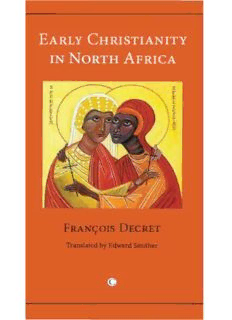
Early Christianity in North Africa PDF
Preview Early Christianity in North Africa
EARL�C HRISTIANI'tY AFRICA s • P. FRAN<;:OlDSE CR ET '1'-0 .... byEdwanI Smltber early christianity in north africa Early Christianity in North Africa ISBN: 978 0 227 90308 7 Early Christianity in North Africa François Decret Translated by Edward Smither James Clarke & Co P.O. Box 60 Cambridge CB1 2NT United Kingdom www.jamesclarke.co ISBN: 978 0 227 17356 5 British Library Cataloguing in Publication Data A record is available from the British Library Copyright © François Decret, 2009 Translation copyright © Edward Smither, 2009 Published by arrangement with Cascade Books, a division of Wipf and Stock Publishers First published by James Clarke & Co, 2011 All rights reserved. No part of this edition may be reproduced, stored electronically or in any retrieval system, or transmitted in any form or by any means, electronic, mechanical, photocopying, recording, or otherwise, without prior written permission from the publisher ([email protected]). Contents Translator’s Preface vii Preface to the English Translation ix 1 Geographical and Historical Background 1 2 origins of the African Church 9 3 tertullian: the “Master” 33 4 Mid-Third-Century Persecution and Crisis in Africa 46 5 Cyprian, the “Pope” of Carthage 69 6 organization and Life of the Third-Century African Churches 82 7 The Donatist schism and the Division of African Christianity 101 8 The Diverse African religious Landscape in Late Antiquity 144 9 Augustine of Hippo and the Glory of the “Great Church” 159 10 The Final stages of the African Church: From the Vandal invasion to the Arab Maghreb 189 Maps 202 Chronology 207 Bibliography 219 Index 223 translator’s Preface Nearly a decade ago, while working on a Master’s thesis on early African Christian theology, i came across François Decret’s book Le christianisme en Afrique du Nord Ancienne. Appropriately so, i found it at a Christian bookstore run by Kabyle Berbers (from Algeria) in Paris. since that time, my research on North African Christian history and theology has been greatly aided by Professor Decret’s work. Presently, in my work as a professor of Christian history, students have often asked me about resources for doing research on the early African church. My response has been to ask them if they read French, because Decret’s work always came to mind as the best place to start. After some conversations with Decret’s publisher seuil (Paris) and the American publisher Wipf and stock (Eugene, oregon), the project to make Decret’s work available in the English-speaking world as Early Christianity in North Africa became a reality. someone has said that traduction (“translation”) is trahison (“trea- son”). indeed, the process of translating an author’s thoughts and expression from one language to another is quite difficult, if not impos- sible. My aim has been to be faithful to Professor Decret’s words and arguments while making them accessible and readable for an English- speaking audience. i am grateful to Dr. Emily Heady, director of the Liberty University Graduate Writing Center, who carefully proofread each chapter and was especially helpful in working out the “wooden- ness” of the translation. My hope is that English-speaking students will find this scholarly primer on early African Christianity, something that has previously not existed in English, as a helpful resource in their research. vii A final note on style: whenever the reader encounters bracketed comments in the footnotes, please note that these are comments made by the translator Edward L. smither, PhD Assistant Professor of Church History & intercultural studies Liberty Baptist Theological seminary (Liberty University) Preface to the English translation The African church entered the pages of history on July 17, 180, as twelve martyrs—five women and seven men—from the village of scilli in Proconsularis (modern tunisia) were sentenced to death by the roman Proconsul Vigelius saturninus. The proconsul had offered the scillitans a period of thirty days to reflect upon their decision, essentially allow- ing them to abandon their faith and to return to the official religion. “in a matter so straightforward there is no considering,” the accused responded. After the proconsul pronounced his sentence, the scillitans were tortured and then beheaded. Unlike the first martyrs in Gaul—be- lievers originally from Asia and Phrygia who were put to death in Lyon in 177—the martyrs of scilli were not Christian immigrants from the East; rather, they were 100 percent African. in some well-known passages of his Apology (ca. 197),1 tertullian provides us with the most important indication of Christianity’s rapid expansion in Africa. Writing to a pagan audience that was angered over the constant growth of the African church—“the outcry is that the state is filled with Christians”2—the polemicist replied: if we are enjoined, then, to love our enemies, as i have remarked above, whom have we to hate? if injured, we are forbidden to re- taliate, lest we become as bad ourselves: who can suffer injury at our hands? . . . Yet, banded together as we are, ever so ready to sac- rifice our lives, what single case of revenge for injury are you able to point to, though, if it were held right among us to repay evil by evil, a single night with a torch or two could achieve an ample ven- geance? . . . We are but of yesterday, and we have filled every place 1. [All English quotations of tertullian are from ANF 3–4.] 2. tertullian Apology 1.7. ix
Description: